Marsens facts for kids
Quick facts for kids
Marsens
|
||
|---|---|---|
|
||
| Country | Switzerland | |
| Canton | Fribourg | |
| District | Gruyère | |
| Area | ||
| • Total | 7.85 km2 (3.03 sq mi) | |
| Elevation | 722 m (2,369 ft) | |
| Population
(Dec 2020 )
|
||
| • Total | 2,034 | |
| • Density | 259.11/km2 (671.1/sq mi) | |
| Postal code |
1633
|
|
| Localities | Marsens, Vuippens | |
| Surrounded by | Corbières, Echarlens, Grangettes, Hauteville, Le Châtelard, Pont-en-Ogoz, Riaz, Sâles, Sorens | |
Marsens is a small town, also called a municipality, in the canton of Fribourg in Switzerland. It's part of the Gruyère district. On January 1, 2001, the nearby town of Vuippens joined with Marsens to form one municipality.
Contents
A Look at Marsens' Past
The name Marsens comes from the Roman god Mars. Archaeologists have found proof that a Gallo-Roman temple, built for this god, once stood here. It was destroyed around the year 260. You can still see the remains of this ancient site today!
Marsens was first mentioned in old writings in 851. Back then, it was called Curtis marsingus. Later, in 929, it was known as Marsingis, and by 1668, it was Marcens. The town used to have a German name, Marsing, but it's not used anymore.
Marsens was also famous for the Humilmont convent, a type of religious building. Its ruins are still just outside the village. More recently, Marsens became known for the psychiatric hospital of the canton, which is located there.
For a long time, the main way people made a living in this area was through farming. But today, Marsens is growing, with more small businesses and industries. New modern homes are being built, but the town still keeps its peaceful views of the mountains and the gentle sound of cowbells nearby.
Marsens' Geography
Marsens covers an area of about 7.8 square kilometers (3 square miles). A big part of this land, about 63.5%, is used for farming. Forests cover about 24.8% of the area. The rest of the land, about 11%, has buildings or roads. A very small part is rivers or lakes.
The municipality is in the Gruyère district. It includes the small villages of Marsens and its neighbor, Vuippens. They are about 5 kilometers (3 miles) from the town of Bulle and 20 kilometers (12 miles) from the city of Fribourg.
Town Symbol: The Coat of Arms
The blazon of Marsens' coat of arms is described as Pally of Six Argent and Gules. This means it has six vertical stripes, alternating between silver (Argent) and red (Gules).
Who Lives in Marsens?
Marsens has a population of about 1,700 people (as of 2023). Over the last ten years, the number of people living here has grown quite a bit, by about 24.7%. Many new people have moved to Marsens, and more babies are being born than people passing away.
Most people in Marsens, about 92.7%, speak French as their main language. German is the second most common language, spoken by about 4% of the people, followed by Italian at 1%.
In 2008, the population was almost evenly split between males (50.3%) and females (49.7%). About 28.9% of the people in Marsens are children and teenagers (0–19 years old). Adults (20–64 years old) make up 55.2% of the population, and seniors (over 64 years old) are 15.9%.
Here's how the population of Marsens has changed over time:

Important Historic Sites
Some buildings in Marsens are so important that they are listed as Swiss heritage sites of national significance. These include the Baillival (Bailiff's) Castle, the Saint-Ignace Chapel, and the Philiponna farm house in Vuippens. The whole Vuippens area is also part of the Inventory of Swiss Heritage Sites, which means it's a special place with important history and culture.
How People Make a Living
In 2010, the unemployment rate in Marsens was quite low, at 1.8%. This means most people who wanted to work had jobs.
People in Marsens work in different areas:
- Primary sector: This is about getting raw materials, like farming or forestry. About 37 people worked in this area.
- Secondary sector: This involves making things, like in factories or construction. About 29 people worked here.
- Tertiary sector: This is about providing services, like healthcare, shops, or restaurants. A large number of people, 599, worked in this sector.
Marsens is a place where more people come to work than leave for work. This means it has many job opportunities! Most people, about 68.7%, use a private car to get to work, while 6.6% use public transportation.
Religious Life
According to a census in 2000, most people in Marsens, about 80.3%, were Roman Catholic. About 5.4% belonged to the Swiss Reformed Church. A small number of people belonged to other Christian churches, or were Islamic or Hindu. About 9.26% of the population said they didn't belong to any church, or were agnostic or atheist.
Weather in Marsens
Marsens gets a good amount of rain or snow each year, about 1212 millimeters (47 inches) on average. It has about 132.5 days of precipitation per year. The wettest month is June, with about 134 millimeters (5.3 inches) of rain or snow. May has the most days with precipitation, about 14.1 days, but with slightly less rain. February is the driest month, with about 78 millimeters (3 inches) of precipitation.
Education in Marsens
In Marsens, about 30.1% of the population has finished upper secondary education, which is like high school. About 10.5% have gone on to higher education, either at a university or a specialized college.
The Canton of Fribourg has a school system that starts with one year of optional Kindergarten. Then, students go to Primary school for six years. After that, there are three years of lower Secondary school, where students are grouped by their abilities. After lower Secondary, students can choose to go to an optional three or four-year upper Secondary school. This can be a gymnasium (which prepares them for university) or a vocational program (which teaches job skills). After upper Secondary, students can go to a Tertiary school or start an apprenticeship.
During the 2010-2011 school year, Marsens had 184 students in 9 classes. There was one kindergarten class with 20 students and eight primary classes with 164 students. While Marsens didn't have its own lower or upper secondary schools, many students from Marsens attended these schools in nearby towns.
See also
 In Spanish: Marsens para niños
In Spanish: Marsens para niños








